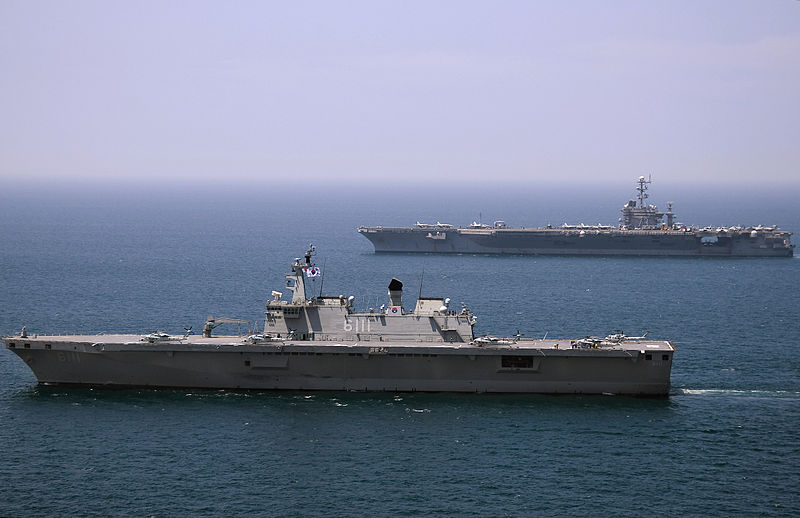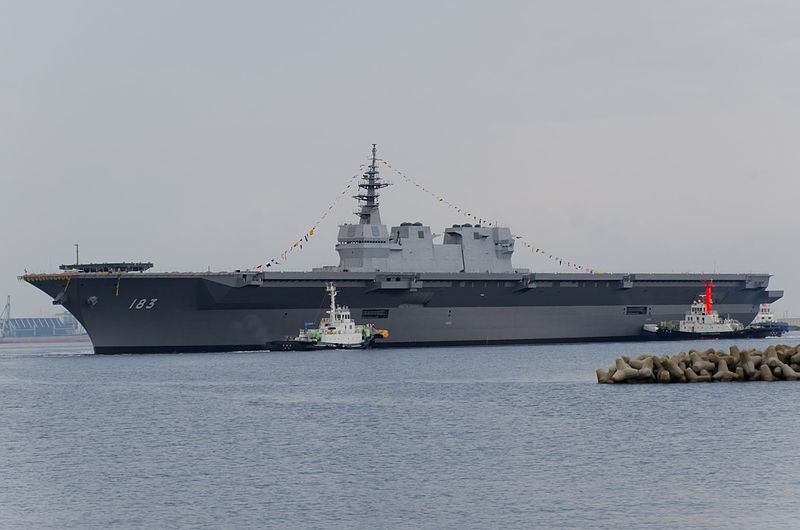At Strategy Page, a look at the Korean and Japanese helicopter carrier ships, including the recently launched ROKS Marado, the second ship of the Dodko class:

The Republic of Korea Navy amphibious landing ship ROKS Dokdo (LPH 6111) and the aircraft carrier USS George Washington (CVN 73) transit the Sea of Japan (July 27, 2010).
U.S. Navy photo by Mass Communication Specialist 3rd Class Charles Oki via Wikimedia Commons.
During May South Korea launched its second Dokdo class large amphibious ship, the 14,500 ton Marado. The first of these ships, the 14,000 ton LPH (Landing Platform Helicopter) Dokdo entered service in 2007 and the Marado is expected to follow in 2020. In addition to being a bit larger than the first Dokdo, the Marado has a number of new features that enhance its ability to operate as an aircraft carrier. This includes more capable electronics, many of them made in South Korea as well modifications to the flight deck and the hanger deck below.
Both 199 meter long Dokdos are similar in appearance and operation to the larger American amphibious ships. The LPH flight deck can handle helicopters, as well as vertical takeoff jets like the F-35B. The Koreans deny that the ship will be used with these jets, but the capability is there. The LPH normally carries 720 combat troops, a crew of 300, ten tanks, seven amphibious assault vehicle, three towed 155mm howitzers and ten trucks. Dokdos carry fifteen aircraft (two V-22 vertical takeoff transports and 13 helicopters) and two LCAC hovercraft in the well deck for landing troops.
The Marado has a redesigned flight deck that can handle two V-22s at once instead of just one. In addition to a more powerful 3-D surveillance radar for tracking aircraft, Marado has two Phalanx anti-missile systems compared to one Goalkeeper system on Dokdo. South Korea is also going to add a locally developed and manufactured K-SAAM anti-aircraft and anti-missile system. This is similar to the existing U.S. made ESSM but with longer range and an improved guidance system.

JS Izumo DDH-183, sister-ship of the JS Kaga DDH-184, both helicopter-equipped destroyers, officially.
Meanwhile, neighbor Japan has taken the Dokdo concept a bit farther. In early 2017 Japan put into service a second 27,000 ton “destroyer” (the Kaga, DDH 184) that looks exactly like an aircraft carrier. Actually, it looks like an LPH, an amphibious ship type that first appeared in the 1950s. This was noted when Izumo, the first Japanese LPH, was launched in 2012 (and entered service in 2015). The Izumos can carry up to 28 aircraft and are armed only with two Phalanx anti-missile systems and a launcher with sixteen ESSM missiles for anti-missile and anti-aircraft defense.
[…]
The Izumo is part of a trend. In 2009, Japan launched its second Hyuga class “LPH”. Earlier in 2009, it commissioned the first of these “helicopter-carrying destroyers”. This was the first Japanese aircraft to enter service since 1945. The Hyuga class are 197 meter (610 foot) long, 18,000 ton warships that operates up to eleven (mostly SH-60) helicopters from a full-length flight deck. Although called a destroyer, it very much looks like an aircraft carrier. While its primary function is anti-submarine warfare, the Hyuga will also give Japan its first real power projection capability since 1945. The Hyuga was also the largest warship built in Japan since World War II.
South Korea could adapt their Dokdos to handle a few F-35Bs by making the flight deck more heat resistant and rearranging the hanger deck. South Korea is getting land based F-35As which would enable them to determine if it would be worth the time and money to adapt their LPHs to carry some vertical takeoff F-35Bs. Sometimes peacekeeping missions involve some peacemaking and F-35Bs would help with that.



